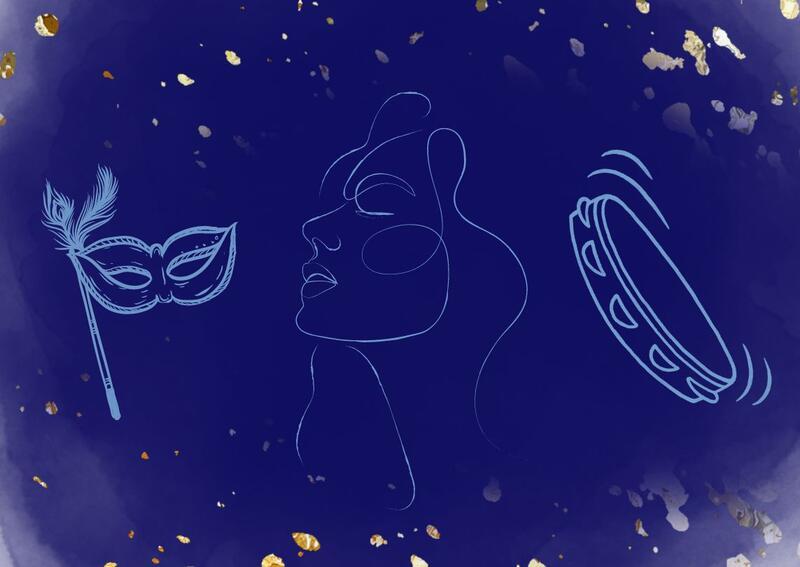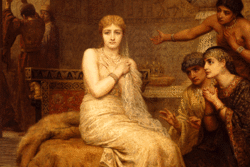The Megillah's Two Models of Leadership
Every holiday excites me, but Purim is one of my favorites. I love everything about it from the tasty hamantaschen, to bright costumes, to carnival games. Yet, although the exuberant celebrations may be what first come to mind, behind it all is the powerful story of the woman that saved the Jewish people from destruction. Her story, told in Megillat Esther, the book of Esther, offers inspiration and guidance for how, in modern times, we can create a future where Jewish women can lead and be listened to.
At the most basic level, Megillat Esther holds promise as a feminist text. While women are often sidelined or left out of bible stories, Megillat Esther has a woman as its hero. Esther plays a central role in the story, as she is the one that saves her people. And even beyond Esther, the supporting characters feature other women in influential roles such as Zeresh, an evil mastermind who is (unfortunately) the brains behind many of her husband Haman’s evil actions, and Vashti, the first Persian queen who was exiled for refusing to come when her husband summoned her to impress his banquet guests.
In the past, I have heard Vashti called the “first feminist,” and for good reason. Throughout history, feminists, both Jewish and non-Jewish, have told her story as an inspiration to modern women. Although Vasthi herself was not Jewish, Jews often study all characters that appear in our histories and texts, and Vashti’s strong-willed character makes her someone Jewish feminists want to embrace. Having lived long before when we typically imagine feminists in action, she shows us that women have been protesting unfair expectations and standing up for themselves forever, and that inspires us to continue the fight. If she wasn’t afraid to speak out and be disobedient, neither should we. Vashti started a movement. She took a first, bold step to show everyone something needed to change—from teaching the king he couldn’t control her, to inspiring the women of Shushan to stand up for themselves too.
Although in today’s world, we praise her for speaking out, the text of Megillat Esther doesn’t paint Vashti as a hero. She sent the king’s advisors into a panic with her defiance. They feared she would make other women realize they could make decisions for themselves and didn’t have to listen to their husbands. The advisors, the king, and the text of the Megillah all seem to agree this is a bad thing. Even today, there are many who are critical of Vasthi. For example, there is a midrash in which Vashti treated Jewish women as slaves. Perhaps Vashti was not such a perfect visionary. Yet, in spite of this midrash, I do think we should still celebrate Vashti for her strength in refusing to be disrespected. However, I also recognize that there is more to be wanted from a heroine for Jewish feminists. In the end, Vashti’s story is not exactly a success story; she got exiled. Vashti’s form of protest did not gain her what she wanted, and therefore, we might also benefit from exploring a different approach to feminism.
For this we turn to the heroine of the Megillah, Esther. In contrast to Vashti, Esther seems a little more passive. She does not jump to action, but rather approaches the king cautiously, and eventually goes about making her request to save the Jews in a pretty round-about way that involves two separate banquets. There is a reason Esther went about her request in this way, namely that proceeding slowly allowed the king to warm up to the idea of granting her requests and eventually do exactly as she asked. The success of this plan shows us that you don’t have to dismantle the system of power to make your voice heard. Esther played by the king’s rules, using her power within the system to win his support and enact change. Her method requires resilience and dedication, but knowing what she stood for allowed her to keep going.
Esther’s success came from the fact that she was always true to herself. The conviction of knowing what was right is what allowed her to make a convincing argument in the end. Even when she hid the fact that she was Jewish from the king she didn’t change who she was inside, and she upheld her Jewish values. For example, Esther was always humble and appreciative rather than demanding. When she prepared to meet the king, she did not request anything special and just let her natural beauty shine. She wasn’t greedy, although she was given the opportunity, and she didn’t feel the need to hide her true self with special gifts. Still though, she caught the attention of the king, proving that she didn’t need to be anything but herself in order to succeed. Again, when it came time to speak out against Haman, Esther did not try to shy away from who she was. Until that moment, she felt it was unnecessary to set herself apart from the others in Shushan and so she didn’t share her identity, but once her people were in danger, she used the power she had gotten to represent them and save them.
Megillat Esther reminds us of a different way to lead, a different way to change the world. Too often today, we expect influential women to be like Vashti, assertive, commanding, and defiant towards authorities (especially men). If we want to give all women opportunities to lead, we need to be comfortable with leaders like Esther too. We need leaders like Esther and Vashti. Each of them has their own way of bringing positive change, and as we look to the future, we need to make sure that all ways of leading and changing the world are welcomed.
This piece was written as part of JWA’s Rising Voices Fellowship.







